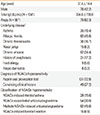1. Namazy JA, Simon RA. Sensitivity to nonsteroidal anti-inflammatory drugs. Ann Allergy Asthma Immunol. 2002; 89:542–550.
2. Jenkins C, Costello J, Hodge L. Systematic review of prevalence of aspirin induced asthma and its implications for clinical practice. BMJ. 2004; 328:434.
3. Szczeklik A, Niżankowska-Moglnicka E, Sanak M. Hypersensitivity to aspirin and non-steroidal antiinflammatory drugs. In : Adkinson NF, Bochner BS, Busse WW, Holgate ST, Lemanske RF, Simons FE, editors. Middleton's allergy: principles & practice. 7th ed. London: Mosby/Elsevier;2009. p. 1227–1243.
4. Stevenson DD. Aspirin and NSAID sensitivity. Immunol Allergy Clin North Am. 2004; 24:491–505.
5. Knowles SR, Drucker AM, Weber EA, Shear NH. Management options for patients with aspirin and nonsteroidal antiinflammatory drug sensitivity. Ann Pharmacother. 2007; 41:1191–1200.
6. Kowalski ML, Makowska J. Use of nonsteroidal anti-inflammatory drugs in patients with aspirin hypersensitivity : safety of cyclo-oxygenase-2 inhibitors. Treat Respir Med. 2006; 5:399–406.
7. Settipane RA, Stevenson DD. Cross sensitivity with acetaminophen in aspirin-sensitive subjects with asthma. J Allergy Clin Immunol. 1989; 84:26–33.
8. Gyllfors P, Bochenek G, Overholt J, Drupka D, Kumlin M, Sheller J, Nizankowska E, Isakson PC, Mejza F, Lefkowith JB, Dahlén SE, Szczeklik A, Murray JJ, Dahlén B. Biochemical and clinical evidence that aspirin-intolerant asthmatic subjects tolerate the cyclooxygenase 2-selective analgetic drug celecoxib. J Allergy Clin Immunol. 2003; 111:1116–1121.
9. Woessner KM, Simon RA, Stevenson DD. The safety of celecoxib in patients with aspirin-sensitive asthma. Arthritis Rheum. 2002; 46:2201–2206.
10. Woessner KM, Simon RA, Stevenson DD. Safety of high-dose rofecoxib in patients with aspirin-exacerbated respiratory disease. Ann Allergy Asthma Immunol. 2004; 93:339–344.
11. Doña I, Blanca-López N, Jagemann LR, Torres MJ, Rondón C, Campo P, Gómez AI, Fernández J, Laguna JJ, Rosado A, Blanca M, Canto G. Response to a selective COX-2 inhibitor in patients with urticaria/angioedema induced by nonsteroidal anti-inflammatory drugs. Allergy. 2011; 66:1428–1433.
12. Kim SH, Ye YM, Palikhe NS, Kim JE, Park HS. Genetic and ethnic risk factors associated with drug hypersensitivity. Curr Opin Allergy Clin Immunol. 2010; 10:280–290.
13. Kowalski ML, Makowska JS, Blanca M, Bavbek S, Bochenek G, Bousquet J, Bousquet P, Celik G, Demoly P, Gomes ER, Niżankowska-Mogilnicka E, Romano A, Sanchez-Borges M, Sanz M, Torres MJ, De Weck A, Szczeklik A, Brockow K. Hypersensitivity to nonsteroidal anti-inflammatory drugs (NSAIDs) - classification, diagnosis and management: review of the EAACI/ENDA(#) and GA2LEN/HANNA*. Allergy. 2011; 66:818–829.
14. Nizankowska-Mogilnicka E, Bochenek G, Mastalerz L, Swierczyńska M, Picado C, Scadding G, Kowalski ML, Setkowicz M, Ring J, Brockow K, Bachert C, Wöhrl S, Dahlén B, Szczeklik A. EAACI/GA2LEN guideline: aspirin provocation tests for diagnosis of aspirin hypersensitivity. Allergy. 2007; 62:1111–1118.
15. Gomes ER, Demoly P. Epidemiology of hypersensitivity drug reactions. Curr Opin Allergy Clin Immunol. 2005; 5:309–316.
16. Shin YS, Lee YW, Choi YH, Park B, Jee YK, Choi SK, Kim EG, Park JW, Hong CS. Spontaneous reporting of adverse drug events by Korean regional pharmacovigilance centers. Pharmacoepidemiol Drug Saf. 2009; 18:910–915.
17. Erbagci Z. Multiple NSAID intolerance in chronic idiopathic urticaria is correlated with delayed, pronounced and prolonged autoreactivity. J Dermatol. 2004; 31:376–382.
18. Kasper L, Sladek K, Duplaga M, Bochenek G, Liebhart J, Gladysz U, Malolepszy J, Szczeklik A. Prevalence of asthma with aspirin hypersensitivity in the adult population of Poland. Allergy. 2003; 58:1064–1066.
19. Zembowicz A, Mastalerz L, Setkowicz M, Radziszewski W, Szczeklik A. Safety of cyclooxygenase 2 inhibitors and increased leukotriene synthesis in chronic idiopathic urticaria with sensitivity to nonsteroidal anti-inflammatory drugs. Arch Dermatol. 2003; 139:1577–1582.
20. Baldassarre S, Schandene L, Choufani G, Michils A. Asthma attacks induced by low doses of celecoxib, aspirin, and acetaminophen. J Allergy Clin Immunol. 2006; 117:215–217.
21. Mastalerz L, Sanak M, Gawlewicz A, Gielicz A, Faber J, Szczeklik A. Different eicosanoid profile of the hypersensitivity reactions triggered by aspirin and celecoxib in a patient with sinusitis, asthma, and urticaria. J Allergy Clin Immunol. 2006; 118:957–958.
22. Umemoto J, Tsurikisawa N, Nogi S, Iwata K, Oshikata C, Tatsuno S, Tanimoto H, Sekiya K, Tsuburai T, Mitomi H, Akiyama K. Selective cyclooxygenase-2 inhibitor cross-reactivity in aspirin-exacerbated respiratory disease. Allergy Asthma Proc. 2011; 32:259–261.
23. Asero R. Risk factors for acetaminophen and nimesulide intolerance in patients with NSAID-induced skin disorders. Ann Allergy Asthma Immunol. 1999; 82:554–558.








 PDF
PDF ePub
ePub Citation
Citation Print
Print



 XML Download
XML Download